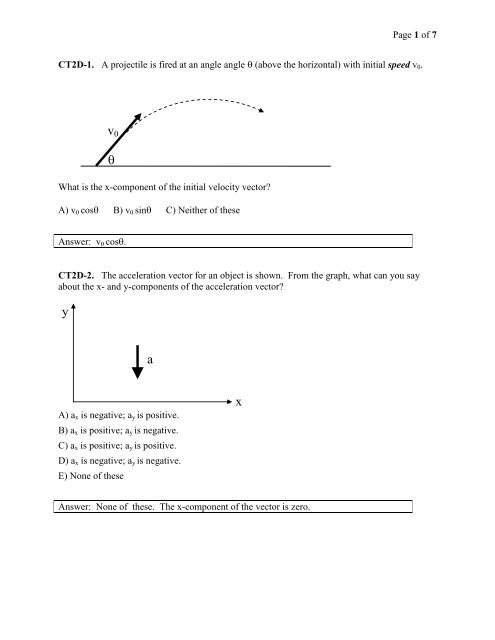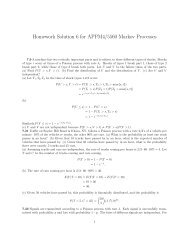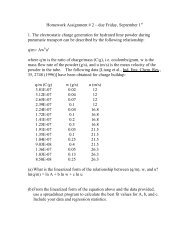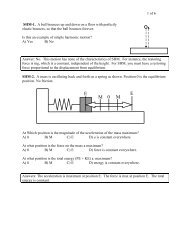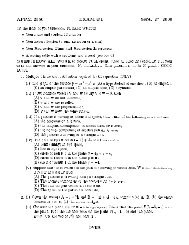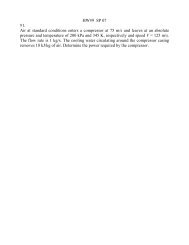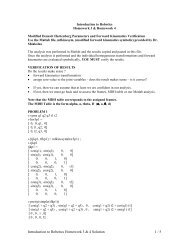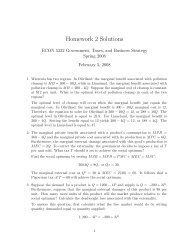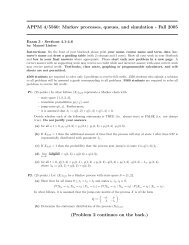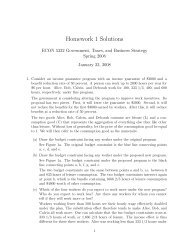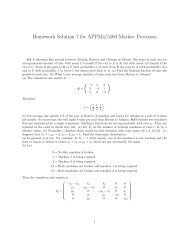2D Motion - cribME!
2D Motion - cribME!
2D Motion - cribME!
Create successful ePaper yourself
Turn your PDF publications into a flip-book with our unique Google optimized e-Paper software.
Page 3 of 7CT<strong>2D</strong>-5. Two projectiles are fired from a cannon. For projectile A, the cannon is tilted upwardat an angle twice that of projectile B. Both projectiles are fired with the same initial speed. (Asusual, neglect air resistance.)ABWhich projectile was in the air longer?A) A B) BC ) A and B were in the air the same length of time.D ) Not enough information to answer the question.Answer: A. Look at the y-motion only to determine which is in flight longer.
Page 4 of 7CT<strong>2D</strong>-6. A hunter shoots a monkey in intergalactic space (where there is no gravity). The bulletflies in a straight line and hits the monkey. The path of the bullet is described by the vectorr r v tequation o oyPath of bulletfinishstartWhen the time t is such that the bullet is half-way to the monkey, the vector r is which vectoron the diagram?yxBACxD) None of theseAnswer: C. A is the vector r 0 . B is the vector v 0 t.
Page 5 of 7CT<strong>2D</strong>-7. A pellet is fired from a slingshot with initial speed v o at an angle . The projectilelands on a building. Where is the speed of the projectile a minimum?BCAv oA) Immediately after the pellet is launched.B) At the apex of the trajectory.C) Just before the pellet hits the building.D) None of these, the speed is constantAnswer: At the apex.CT<strong>2D</strong>-8. A rifle is accurately aimed at a rabid monkey hanging from the branch of a tree. Theinstant the gun is fired, the monkey releases the branch and starts falling. The monkey is wellwithin the range of the rifle. The initial speed of the bullet is v o . What happens?gunv oA ) The bullet finds its target, regardless of the value of v o . (Assuming v o still large enough toreach the air below the monkey.)B ) The bullet hits the monkey only if v o is large enough.C ) The bullet misses.Answer: A. See the discussion in the lecture notes.
Page 6 of 7CT<strong>2D</strong>-9. Consider the velocities at times t 1 and t 2 . These are the velocity vectors V 1 and V 2 .Draw the V 1 + V = V 2 vector diagram. What is the direction of V, the change in velocitybetween t 1 and t 2 ?A) straight up B) straight down C) upper right D) lower rightt 1t 2v oAnswer: straight down . The direction of V is the same as the direction of theacceleration a.CT<strong>2D</strong>-10. True or False: If the speed of an object is constant, its acceleration must be zero.A) True B) FalseAnswer: False. An object moving with constant speed around a circle has a non-zeroacceleration, because the direction of the velocity is changing.
Page 7 of 7CT<strong>2D</strong>-11. A particle is moving along the path shown, with constant speed. Its velocity vector attwo different times is shown. What is the direction of the acceleration when the particle is atpoint X?BXACAnswer: A. Draw the V1-V2-deltaV diagram!D(E) None of theseCT<strong>2D</strong>-12. A race car travels around the track shown at constant speed. Over which portion ofthe track is the magnitude of the acceleration the smallest?2431A) From 1 to 2 B) From 3 to 4 C) Neither of these D) Both of theseHint: it’s a trick question !Answer: Neither of these. The acceleration is zero on the straight portions of the track.


